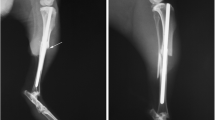Summary
Osteoid osteoma is a tumour of bone characterised by pain which is relieved by aspirin and nonsteroidal anti-inflammatory drugs. Very high levels of prostaglandins have been found in the lesion. In five patients with osteoid osteoma, prostaglandin E 2 (PGE 2 ) and prostacyclin (PGI 2 ) synthesis in the nidus yielded 1155.6±496.5 (mean±SD) and 245.2±89.8 pg/mg respectively, values which are 33 and 26 times higher than in fragments of normal bone. The sclerotic bone around the nidus produced both prostaglandins at the same rate as normal bone. In three patients the excretion rate of the major urinary metabolite of systemic PGI 1 was reduced to 50% one month after removal of the tumour. The urinary excretion rate of 6-keto-PGF 1 α, reflecting intrarenal PGI 2 synthesis, was not changed after operation. These results offer new insight into the pain mechanism in osteoid osteoma.
Résumé
L'ostéome ostéoïde est une tumeur osseuse caractérisée par des douleurs qui sont calmées par l'aspirine et les anti-inflammatoires non stéroïdiens. Des taux très élevés de prostaglandines ont été trouvés dans cette lésion. Chez trois malades présentant un ostéome ostéoïde la prostaglandine E 2 (PGE 2 ) et la prostacycline (PGI 2 ) synthétisés dans le nidus atteignaient respectivement 1155.6±496.5 et 245.2±89.8 pg/mg, valeurs qui étaient 33 et 26 fois plus élevées que dans des fragments d'os normal. L'os scléreux entourant le nidus produisait les deux prostaglandines au même taux que l'os normal. Chez trois malades le taux d'excrétion des principaux métabolites urinaires de la PGI 2 systémique était réduit de moitié un mois après l'ablation de la tumeur. Le taux d'excrétion urinaire de la 6-keto-PGF1α, traduisant la synthèse rénale de la PGI 2 , n'a pas été modifié par l'opération. Ces résultats permettent une nouvelle approche du mécanisme de la douleur dans l'ostéome ostéoöide.
Similar content being viewed by others
References
Brash AR, Jackson EK, Saggese CA, Lawson JA, Oates JA, FitzGerald GA (1983) Metabolic disposition of prostacyclin in humans. J Pharmacol Exp Ther 226: 78–87
Byers PD (1968) Solitary begnign osteoblastic lesions of bone. Osteoid osteoma and osteoblastoma. Cancer 22: 43–57
Ciabattoni G, Boss AH, Daffonchio L, Daugherty J, FitzGerald GA, Catella F, Dray F, Patrono C (1987) Radioimmunoassay measurement of 2,3-dinor metabolites of prostacyclin and thromboxane in human urine. In: B Samuelsson, R Paoletti, PW Ramwell (eds) Advances in prostaglandin, thromboxane and leukotriene research. Raven Press, New York 17B: 598–602
Ciabattoni G, Boss AH, Patrignani P, Catella F, Simonetti BM, Pierucci A, Pugliese F, Filabozzi P, Patrono C (1987) Effects of sulindac on renal and extrarenal eicosanoid synthesis. Clin Pharmacol Ther 41: 380–383
Esquerdo J, Fernandez CF, Gomar F (1976) Pain in osteoid osteoma: histological facts. Acta Orthop Scand 47: 520–524
FitzGerald GA, Brash AR, Falardeau P, Oates JA (1981) Estimated rate of prostacyclin secretion into the circulation of normal man. J Clin Invest 68: 1272–1276
Golding JSR (1954) The natural history of osteoid osteoma. J Bone Joint Surg [Br] 36: 218–229
Greco F, Tamburrelli F, Laudati A, La Cara A, Di Trapani G (1988) Le fibre nervose nell'osteoma osteoide. Italian J Orthop Traumatol 16: 91–96
Guzzanti V, Di Lazzaro A, Gasparini G, Bosman C, Bodrini R (1985) Osteoma osteoide della diafisi femorale a sintomatologia atipica in eta' pediatrica. Riv Ital Ortop Traumatol Pediatr 1: 297–300
Halperin N, Gadoth N, Reif R, Axer A (1982) Osteoid osteoma of the proximal femur simulating spinal root compression. Clin Orthop 162: 191–194
Ippolito E, Postacchini F (1983) Osteoma osteoide del collo femorale simulante una sindrome lomboradicolare. Italian J Orthop Traum 9: 515–518
Makley JT, Dunn MG (1982) Prostaglandin synthesis by osteoid osteoma. Lancet II: 42
Patrono C, Ciabattoni G, Greco F, Grossi-Belloni D (1976) Comparative evaluation of the inhibitory effects of Aspirin like drugs on prostaglandin production by human platelets and synovial tissue. In: B Samuelsson, R Paoletti (eds) Advances in prostaglandin, thromboxane and leukotriene research. Raven Press, New York, 1: 125–131
Patrono C, Pugliese F, Ciabattoni G, Patrignani P, Maseri A, Chierchia S, Peskar BA, Cinotti GA, Simonetti BM, Pierucci A (1982) Evidence for a direct stimulatory effect of prostacyclin on renin release in man. J Clin Invest 69: 231–239
Schulman L, Dorfman HD (1970) Nerve fibres in osteoid osteoma. J Bone Joint Surg [Am] 52: 1351–1353
Sherman MS, Mc Farland G (1965) Mechanism of pain in osteoid osteomas. S Medi J 58: 163–166
Steiner GC (1976) Ultrastructure of osteoid osteoma. Human Pathol 7: 309–325
Author information
Authors and Affiliations
Rights and permissions
About this article
Cite this article
Greco, F., Tamburrelli, F. & Ciabattoni, G. Prostaglandins in osteoid osteoma. International Orthopaedics 15, 35–37 (1991). https://doi.org/10.1007/BF00210531
Issue Date:
DOI: https://doi.org/10.1007/BF00210531




